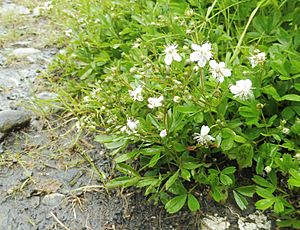Sibbaldiopsis facts for kids
Quick facts for kids Sibbaldiopsis |
|
|---|---|
 |
|
| Scientific classification | |
| Kingdom: | |
| (unranked): | |
| (unranked): | |
| (unranked): | |
| Order: | |
| Family: | |
| Subfamily: | |
| Genus: |
Sibbaldiopsis
Rydb.
|
| Species: |
S. tridentata
|
| Binomial name | |
| Sibbaldiopsis tridentata (Aiton) Rydb.
|
|
| Synonyms | |
|
Potentilla tridentata Aiton |
|
Sibbaldiopsis tridentata is a special kind of plant that belongs to the Rosaceae family, also known as the rose family. It's the only species in its group, called a genus. People often call it by other names like three-toothed cinquefoil, shrubby fivefingers, or wineleaf. This plant was once thought to be part of the Potentilla group.
How This Plant Got Its Name
The plant Sibbaldiopsis tridentata was first described by a scientist named William Aiton. Later, another scientist, Per Axel Rydberg, made some corrections to its description.
For a long time, this plant was known as Potentilla tridentata. But then, scientists used new ways to study its genes. They found out that it was actually more closely related to a different plant from cold, northern areas called Sibbaldia procumbens. Because of this discovery, they decided to give it its very own group, or genus.
The name Sibbaldiopsis comes from the name Sibbaldia and a part that means "resembling." So, Sibbaldiopsis means "resembling Sibbaldia."
Where This Plant Lives
Sibbaldiopsis tridentata likes to grow in dry, rocky places. It prefers soil that is a bit acidic, often found on gravelly shores or rocky areas. It needs a lot of sunshine to grow well. You can often spot it on shale outcrops, which are places where layers of rock are exposed.
This plant is found across the central and eastern parts of the United States. It also grows in the Appalachian Mountains, even in places far apart from each other. You can find it in Canadian provinces, including Alberta and those further east, and even in Greenland. In Nova Scotia, Canada, it's very common in the middle of the Annapolis Valley and near cliffs. The most southern places where it grows are in Georgia and North Carolina. Here, it lives on high rock outcrops and open, grassy areas in the mountains.
Sadly, Sibbaldiopsis tridentata is considered endangered in five states in the U.S. This means it's important to protect it.
What This Plant Looks Like
Sibbaldiopsis tridentata is a short plant that stays green all year round. It usually grows up to about ten inches tall. Its leaves are made up of three smaller leaflets, like a clover. These leaves usually grow from the base of the plant in an alternating pattern. Each leaflet can be up to an inch and a half long and half an inch wide.
The leaflets have a unique shape, wider at the tip and narrower at the base, with three small teeth at the very end. The leaves are shiny and stay green, but they can turn a beautiful deep red color in the fall if the plant gets a lot of sun.
The plant's branches are soft and covered in fine hairs, but its roots are strong and woody.
Its flowers are small and white, with five petals and five sepals (leaf-like parts under the petals). They grow in clusters. Each flower looks a bit like the flowers from the Potentilla group.
This plant blooms for about two to three months, usually from June to August. After the flowers fade, the triangular sepals fold up. Inside, tiny, hairy brown seeds begin to grow.

